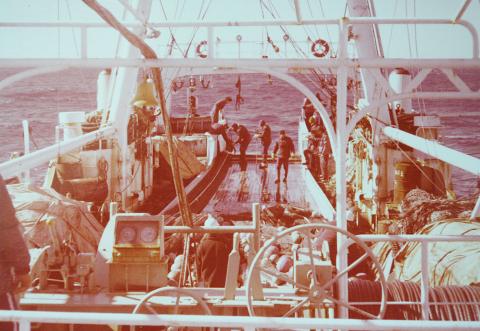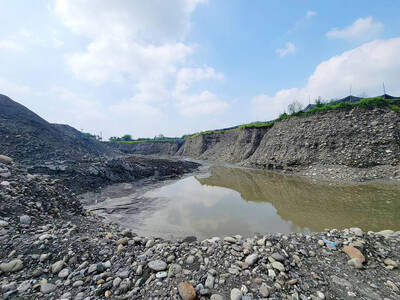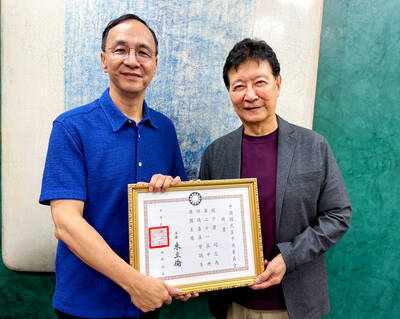Taiwan in Time: Dec. 21 to Dec. 27
After a 17,000km journey having survived devastatingly strong winds in regions dubbed the “roaring 40s, furious 50s and shrieking 60s” in reference to latitudes, the 711-ton Hai Kung (海功號) trawler ship drifted in the Antarctic waters in the middle of a snowstorm.
It was Jan. 23, 1977, World Freedom Day for Taiwan and South Korea. The crew of more than 30 researchers, sailors and journalists watched emotionally as the Taiwanese flag slowly rose in the frigid wind, its bright colors punctuating the gray skies.

Photo: Tang Sheng-yang, Taipei Times
It had been almost two months since they left Keelung in Taiwan’s first expedition ever to the bottom of the Earth. After making several rally cries, denouncing communism, slavery and fascism and calling for world peace, the crew produced a glass bottle containing a copy of Confucius’ Age of Great Harmony (禮運大同篇), hand-written by Teng Huo-tu (鄧火土), head of the Fisheries Research Institute, and dropped it into the ocean.
The bottle was meant to be buried in Antarctica’s ice sheet, and the flag planted on land, but the ship, lacking icebreakers and other equipment to properly navigate the perilous glaciers, could only sail near the continent while hauling in massive amounts of Antarctic krill. There were an estimated 40 to 60 billion tonnes of the shrimp-like crustaceans in the ocean, which were seen as a potential protein source for Taiwan’s increasing population amid unsure times as the country’s international standing continued to falter.
Two months later, the ship returned to Keelung with 140 tonnes of the catch to great fanfare. They were heroes.

Photo: Weng Yu-huang, Taipei Times
Taiwan’s development of its new fishing sources and methods became an urgent issue after the 1974 Third UN Conference on the Law of the Sea, where a proposal was made for a 200-nautical mile exclusive economic zone for coastal countries. Fishing experts were worried that it would greatly reduce the country’s traditional fishing grounds.
Members of the Joint Commission on Rural Reconstruction (today’s Council of Agriculture) decided to act preemptively by exploring possibilities in the Antarctic, where no Taiwanese ship had ever gone.
Hai Kung was built under Teng’s supervision for this purpose, completed in July 1975. Without icebreakers, it relied on sonar technology to avoid icebergs. It embarked on its maiden voyage on Dec. 24 that year, testing different equipment in the fishing grounds north of Taiwan in the East China Sea.
One year later, Hai Kung was deemed ready to make the big trip. It departed Keelung on Dec. 2, reaching Cape Town on Dec. 28, where it underwent more reinforcements and repairs before heading further south a week later.
Journalist Lu I-ming (呂一銘) recalls in his book about the journey passing through the various storm zones, where waves as high as mountains would hit the ship relentlessly, tilting it as much as 40 degrees. On Jan. 10, 1976, the crew shed tears of joy as they finally reached the Antarctic Ocean.
Lu writes that the ship almost got turned back at one point because of a telegram sent from Taiwan ordering the crew not to go further south than 50 degrees, which was revealed later to be a typo, as the officials actually meant 70 degrees.
The return journey was just as perilous, but the crew made it safely back to Cape Town on Feb. 17. Here, the ship reportedly received a mysterious crate from Taiwan’s ambassador to South Africa to bring back home with them. Several crew members later reported that they felt that the ship had a secret mission, especially when they were ordered to depart straight for Taiwan, without stops, before the sun even came up. Even the journalists, who had planned to visit England, were ordered to return home immediately.
A crew member said years later that the crate was delivered to the National Chung-Shan Institute of Technology and Science, prompting them to suspect that it was a missile. The book, Mission Antarctic (極地任務) published by the Taiwan Fisheries Economics Development Association and Chung Cheng Agriculture and Social Welfare Foundation states that indeed it was a military purchase, and suggests that it was a “type of radioactive heavy metal element,” prompting speculation that it was uranium.
There has been no definite conclusion yet.
Hai Kung would make several more expeditions to Antarctica before it was retired in 1993. Alas, the krill never became a food source reportedly because of its putrid smell and lack of meat, and is used today mostly as fishing bait. After its years of service and groundbreaking achievements, Hai Kung was moved ashore in 1998 at Keelung’s Bisha wharf (碧砂), where it sat mournfully, rusting and falling apart until it was recently restored.
Taiwan in Time, a column about Taiwan’s history that is published every Sunday, spotlights important or interesting events around the nation that have anniversaries this week.

The depressing numbers continue to pile up, like casualty lists after a lost battle. This week, after the government announced the 19th straight month of population decline, the Ministry of the Interior said that Taiwan is expected to lose 6.67 million workers in two waves of retirement over the next 15 years. According to the Ministry of Labor (MOL), Taiwan has a workforce of 11.6 million (as of July). The over-15 population was 20.244 million last year. EARLY RETIREMENT Early retirement is going to make these waves a tsunami. According to the Directorate General of Budget Accounting and Statistics (DGBAS), the

Last week the story of the giant illegal crater dug in Kaohsiung’s Meinong District (美濃) emerged into the public consciousness. The site was used for sand and gravel extraction, and then filled with construction waste. Locals referred to it sardonically as the “Meinong Grand Canyon,” according to media reports, because it was 2 hectares in length and 10 meters deep. The land involved included both state-owned and local farm land. Local media said that the site had generated NT$300 million in profits, against fines of a few million and the loss of some excavators. OFFICIAL CORRUPTION? The site had been seized

Next week, candidates will officially register to run for chair of the Chinese Nationalist Party (KMT). By the end of Friday, we will know who has registered for the Oct. 18 election. The number of declared candidates has been fluctuating daily. Some candidates registering may be disqualified, so the final list may be in flux for weeks. The list of likely candidates ranges from deep blue to deeper blue to deepest blue, bordering on red (pro-Chinese Communist Party, CCP). Unless current Chairman Eric Chu (朱立倫) can be convinced to run for re-election, the party looks likely to shift towards more hardline

Sept. 15 to Sept. 21 A Bhutanese princess caught at Taoyuan Airport with 22 rhino horns — worth about NT$31 million today — might have been just another curious front-page story. But the Sept. 17, 1993 incident came at a sensitive moment. Taiwan, dubbed “Die-wan” by the British conservationist group Environmental Investigation Agency (EIA), was under international fire for being a major hub for rhino horn. Just 10 days earlier, US secretary of the interior Bruce Babbitt had recommended sanctions against Taiwan for its “failure to end its participation in rhinoceros horn trade.” Even though Taiwan had restricted imports since 1985 and enacted